




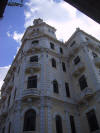
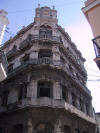



























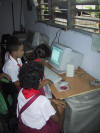
This photo (together with the one below were shown in the country profile on Cuba in the Global View broadcast on Cuba by the US based History Channel on 5 October 2005 1:15PM)







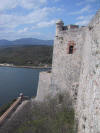

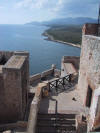
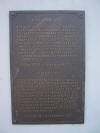


 |
Havanna in the morning as seen from the Habana Libre Hotel (in the foreground the university) |
 |
Catedral de San Cristobál at the Plaza de La Catedral in Havanna |
 |
Book market at the Plaza de San Francisco in Havanna |
 |
"Capitolio Nacional" as seen through acades at the Plaza Veja in Havanna |
 |
Plaza Veja. The building in the middle is not yet renovated whereas the others are |
 |
Impressive building at the Plaza Veja already renovated |
 |
Other palace in Havanna still in process of being revived. Large parts of Havanna were neglected for decades as the Cuban government first wanted to develop provincial cities (electriticy etc.) to prevent a migration to Havanna. |
 |
The Bay of Havanna as seen from the garden of the Nacional Hotel |
 |
The Nacional Hotel. Famous hotel where in pre-revolutionary times people like Frank Sinatra etc. were performing |
 |
The monument for the nacional hero José Martí who liberated Cuba from the Spanish (Paza de la Revolucíon). |
 |
Che Cuevara had his office in this building opposite the monument for José Martí. |
 |
Street scene as seen from the Capitolio Nacional |
 |
The 50ies car clearly give Cuba a clear distinction from other latin-american countries. Other than that Cuba is many ways very similar. In the background is another typical Havanna sight. The large truck-busses shuttling commuters to the suburbs. |
 |
Capitolio Nacional which used to house the Congress and now is the headquarters of the Cuban scientific society. Clearly as in many US states this Congress was built copying the capitl in Washington D.C. The Cuban flag in fact was meant to be the flag of the 52nd US state. |
 |
More street scenes around the Capitolio Nacional |
 |
More 50ies cars |
 |
Tobaco field north of Havanna (close to Pinar del Río the tabaco growing region). |
 |
Stand of a fruit man north of Havanna. The fruits were fantastic. Even the grapefruit was not bitter. |
 |
View towards the Viñales Valley with its bizarre formations similar to Guilin in China |
 |
ditto |
 |
Concert in the Nacional Hotel were guests from the Estados Unidos got the same applause as people from other countries |
 |
Alligators at the La Boca de Guamá close to the Playa Girón (pig's bay). |
 |
There are not only old cares but also old trucks. The yellow number plate indicates a privately owned truck/car. Vehicles with blue number plates are government owned and have to pick up hitch-hikers (transport within Cuba is still very difficult). |
 |
Plaza Martí in Cienfuegos a nice town south-west of Havanna. |
 |
Another view of Plaza Martí |
 |
ditto |
 |
Shopping alley in Cienfuegos (on a Sunday). As always in Cuba the streets are very clean. |
 |
Trinidad a colonial city which is virtually unchanged from the colonial timaes (UNESCO cultural world heritage). |
 |
View over Trinidad |
 |
View over Paza Mayor with the Iglesia de la Santísima Trinidad |
 |
Sugar cane fields in the Valle San Luís close to Trinidad. The produce of this valley was very important to the early development of Cuba. Today the soil in much of Cuba is exploited and the yield is dwindling. Already have of the sugar plants had to be closed down. |
 |
"US Cuba Friendshipment Caravan" with a US and Cuban flag as seen in Bayano. Another sign of the astonishingly relaxed attitude of the Cuban people towards the US. Where there were flags in front of hotels, the US flag was usually flying as well. |
 |
Main road between Bayano and Camagüey. |
 |
Shopping alley in Camagüey on a workday. There are only very few socialist stores with dusty products. However, in the nice shops only US dollars are accepted. Actually I never got to see a peso during my whole stay in Cuba. |
 |
Small school in a rural village. All schools were equipped with computers
and all class rooms with TV sets and videos a year ago. This photo (together with the one below were shown in the country profile on Cuba in the Global View broadcast on Cuba by the US based History Channel on 5 October 2005 1:15PM) |
 |
Cuban kids at a rural school |
 |
Basilica El Cobre close to Santiago de Cuba |
 |
Catedral de Nuestra Señora de la Asunción at the Parque Céspedes in Santiago de Cuba as seen from the Casa de Don Diego Velázquez |
 |
The Machado barracks which Fidel Castro attacked in his first revolutionary attempt (was then exiled) |
 |
The Machado barracks were soon after the revolution converted to schools along with many other barracks. |
 |
Mausoleum for José Martí in Santiago de Cuba. Every half hour there is changing of the guard ceremony |
 |
Harbor of Santiago de Cuba looking towards "El Morro" one of the many fortresses built in the Caribean by the Italian engineer |
 |
"El Morro" was never captured. In the US - Spanish war (were the US came to help the Cubans) the Spanish fleet was trapped in the harbor. They didn't give up but came out of the harbor one after another only to be sunk by the US ships waiting in front of the harbor. |
 |
View from El Morro into the harbor |
 |
There were many picture to take at El Morro |
 |
Memory for the "brave" Cuban and "generous" US soldiers who fought the last victorious battle against the Spanish on the Hill of San Juan in Santiago the Cuba in July 1898. This was a very important moment in world history, as the US succeeded the Spanish as world Superpower (the US did gobble up the remainder of the Spanish empire, not only Cuba, but also the Philippines etc.) |
 |
Mansion of Bacardí founder of the Bacardí Rum company and at the time mayor of Santiago de Cuba |
 |
Caribean beach in Holguín. There are numerous world class beaches with the usual "all-inclusive resorts" on Cuba, not only in Varadero and Holguín but also Trinidad. |